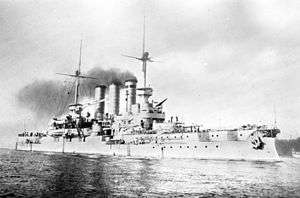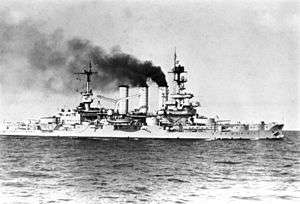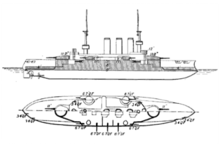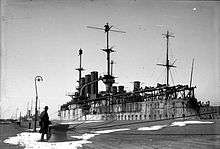Braunschweig-class battleship
 Braunschweig-class battleship | |
| Class overview | |
|---|---|
| Name: | Braunschweig class |
| Builders: | Germaniawerft, Schichau, AG Vulcan |
| Operators: |
|
| Preceded by: | Wittelsbach class |
| Succeeded by: | Deutschland class |
| Built: | 1901–1906 |
| In commission: | 1905–1945 |
| Completed: | 5 |
| Scrapped: | 5 |
| General characteristics | |
| Type: | Pre-dreadnought battleship |
| Displacement: | 14,394 t (14,167 long tons) |
| Length: | 127.7 m (419 ft) |
| Beam: | 22.2 m (72 ft 10 in) |
| Draft: | 8.1 m (26 ft 7 in) |
| Propulsion: |
|
| Speed: | 18 knots (33 km/h; 21 mph) |
| Range: | 5,200 nmi (9,600 km; 6,000 mi) at 10 knots (19 km/h; 12 mph) |
| Complement: |
|
| Armament: |
|
| Armor: |
|
The Braunschweig-class battleships were pre-dreadnought battleships of the Kaiserliche Marine (the German Imperial Navy). The class comprised five ships: Braunschweig, Elsass, Hessen, Preussen, and Lothringen. The ships were an improvement over the preceding Wittelsbach class; the ships mounted a more powerful main battery, were two knots faster, and had better armor protection.
The five ships all saw active service during World War I, primarily as coast defense ships in the IV Battle Squadron. Hessen was transferred to the II Battle Squadron in 1916 and took part in the Battle of Jutland on 31 May–1 June 1916. All five ships of the class were retained by the Reichsmarine following Germany's defeat in World War I, and saw further service in a variety of roles. Hessen was eventually rebuilt as a radio-controlled target ship, while Preussen and Lothringen were converted into minesweeper tenders. All of the ships, with the exception of Hessen, were broken up in the 1930s; Hessen survived until the end of World War II, when she was taken over by the Soviet Navy, for continued use as a target ship.
Design
General characteristics

The Braunschweig-class ships were 413 ft 3 in long at the waterline, and 419 ft (128 m) overall. The ships had a beam of 73 ft (22 m), and a draft of 26 ft 7 in (8.10 m). The ships had thirteen watertight compartments and a double bottom for 60 percent of the length of the hull. The ships displaced 13,208 tonnes at their designed weight, and 14,394 t at a full load.[1]
The ships were described as good sea-boats, but were prone to heavy pitching. The ships were responsive and had a tight turning radius at low speed, but at hard rudder of 12 degrees, the ships lost up to 70 percent speed. The ships had a crew of 35 officers and 708 men normally, and when serving as a squadron flagship, they had an additional 13 officers and 66 men. The ships carried a number of smaller boats aboard, including two picket boats, two launches, a pinnace (later removed), two cutters, two yawls, and two dinghies.[2]
Propulsion
The ships of the Braunschweig-class were propelled by three shaft triple expansion engines that were rated at 16,000 metric horsepower (16,000 ihp; 12,000 kW). The triple expansion engines were powered by eight Marine type boilers and six cylindrical boilers. After 1915, oil-firing capability was added to supplement the coal-fired boilers.[lower-alpha 1] The ships had a single rudder and three screws. The two outer propellers were three-bladed, and 4.8 m (5.24 yd) in diameter. The center screw was four-bladed and 4.5 m (4.92 yd) in diameter. The ships' top speed was rated at 18 knots (33 km/h; 21 mph). During trials, however, the engines produced between 16,478 and 16,980 PS (16,253 and 16,748 ihp; 12,120 and 12,489 kW), and a top speed between 18.2 and 18.7 knots (33.7 and 34.6 km/h; 20.9 and 21.5 mph). The ships of the class could steam 5,200 nautical miles (9,600 km; 6,000 mi) at a cruising speed of 10 knots (19 km/h; 12 mph), with the exception of Hessen. Hessen suffered from unstable steering, which increased fuel consumption and shortened her operational range to 4,530 nmi (8,390 km) at 10 knots (19 km/h; 12 mph). The first two ships—Braunschweig and Elsass had four generators that produced 230 kW (74 V), while three following ships—Hessen, Preussen, and Lothringen had four turbo-generators that provided 260 kW (110 V).[1]
Armor
The ships were equipped with Krupp armor. The deck armor was 40 mm (1.57 in) thick on the horizontal, and ranged between 140–75–140 mm (5.51–2.95–5.51 in) in the sloped deck armor. The main armored belt was 250 mm (9.8 in) thick. The forward conning tower had a 50 mm (1.97 in) thick roof, while the sides were 300 mm (11.8 in) thick. The aft conning tower had a roof protected by 30 mm (1.2 in) of armor plating and 140 mm (5.51 in) armor on the sides. The ship's citadel was also protected by 140 mm of armor. The main battery turrets had 50 mm thick roofs and 250 mm sides. The secondary battery turrets were protected by 150 mm (5.9 in) of armor, while the casemated guns had gun shields 70 mm (2.75 in) thick.[1]
Armament

The ships' main armament was increased from previous designs, but still weaker than contemporary foreign battleships.[3] The main armament comprised four 28 cm (11 in) SK L/40[lower-alpha 2] quick-firing guns in twin turrets, increased from four 24 cm (9.4 in) guns from previous designs, compared with the 12 in (30 cm) guns used on many foreign ships. The guns could depress down to −4 degrees, and elevate to +30 degrees, which enabled a maximum range of 18,800 m (20,600 yd).[4] The guns fired 529 lb shells at a muzzle velocity of 2690 feet per second (820 m/s)[4] The main battery had a total of 340 shells, for 85 shells per gun.[2]
The secondary battery consisted of fourteen 17 cm (6.7 in) SK L/40 quick-firing guns, four of which were mounted in single turrets amidships, with the remaining ten in casemates around the superstructure. The guns fired 141 lb shells at a muzzle velocity of 2789 f/s (850 m/s). The turret-mounted guns could be elevated to 30 degrees, for a maximum range of 16,900 m (18,500 yds), while the casemated guns could only elevate to 22 degrees, and had a correspondingly lower range of 14,500 m (15,850 yd).[4] These guns had a total of 1820 shells, for 130 rounds per gun. To transit the Kiel Canal, the three central 17 cm casemated guns had to be withdrawn into their housings, as they were unable to train fully flush with the sides of the ships. With the guns fully emplaced, the ships would have been too wide to fit in the canal.[2]
The ships also had fourteen 8.8 cm (3.5 in) SK L/35 quick-firing guns in casemates along the length of the ship. The guns fired 15.4 lb (7.0 kg) shells at a muzzle velocity of 2,526 f/t (770 m/s), and could be elevated to 25 degrees for a maximum range of 9,090 m (9,940 yd).[4] They were also armed with six 45 cm (18 in) torpedo tubes, with a total of 16 torpedoes.[2]
Construction
Braunschweig was laid down at the Germaniawerft shipyard in Kiel in 1901, was launched on 20 December 1902, and commissioned into the fleet on 15 October 1904. Elsass was built at Schichau in Danzig, starting in 1901. The ship was launched on 26 May 1903 and commissioned on 29 November 1904. Hessen was also built at Germaniawerft, starting in 1902. She was launched on 18 September 1903, and commissioned just over two years later on 19 September 1905. Preussen was laid down in 1902 at the AG Vulcan shipyard in Stettin, launched on 30 October 1903, and commissioned into the fleet on 12 July 1905. Lothringen, the final ship of the class, was laid down at the Schichau dockyards in 1902. She was launched on 27 May 1904, and commissioned just under two years later on 18 May 1906.[5]
Service history
World War I
At the start of the First World War, the members of the Braunschweig class were assigned to IV Battle Squadron under the command of Vice Admiral Ehrhard Schmidt, and tasked with coastal defense duties.[6] Braunschweig and Elsass both participated in the early portion of the Battle of the Gulf of Riga. The two ships kept the Russian pre-dreadnought Slava at bay while a Russian minefield was cleared, but the Russian forces put up a strong defense. Vice Admiral Schmidt decided to withdraw his forces when it became apparent that the mine clearing had taken too long, and there wasn't sufficient daylight left for the minelayer Deutschland to lay a minefield of its own.[7] In 1916, Hessen was assigned to II Battle Squadron, and participated in the Battle of Jutland on 31 May–1 June 1916. Late in the day on the 31st, Hessen and the other pre-dreadnoughts of the II Battle Squadron briefly engaged Vice Admiral David Beatty's 1st Battlecruiser Squadron, and in doing so, covered the withdrawal of the battered German battlecruisers under the command of Franz von Hipper.[8]
Starting in 1916, the ships of the Braunschweig class were withdrawn from active service, primarily because of manpower shortages.[9] Braunschweig was used as a training ship, and on 20 August 1917, was converted into a barracks ship in Kiel. Elsass was also used as a barracks and training ship in Kiel, having been withdrawn from active service on 25 July 1916. Hessen was converted into a depot ship in Brunsbüttel in 1917, while Preussen became a depot ship in Wilhelmshaven that same year. Lothringen was withdrawn from service in 1917 and used as an engineer training ship in Wilhelmshaven.[2] Guns removed from these ships starting in 1916 were used by the Imperial Army in World War I as railway guns.
Post-World War I

Because all of Germany's powerful dreadnoughts had either been scuttled in Scapa Flow or ceded to the Allies as war prizes, the Braunschweig-class battleships were recommissioned into the newly reorganized Reichsmarine.[9] In the years following World War I, Braunschweig, Elsass, and Hessen were to be rebuilt as coastal defense ships, although this plan was abandoned.[3] Braunschweig served in the Reichsmarine from 1921 to 1926, at which point she was withdrawn from active duty. On 31 May 1931, she was stricken and converted into a hulk at Wilhelmshaven, and eventually scrapped. Elsass saw active duty in the fleet from 1924 until 25 February 1930, at which point she was removed from active service. On 31 March 1931, she was stricken, hulked in Wilhelmshaven. On 31 October 1935, Elsass was sold to Norddeutscher-Lloyd in Bremerhaven, and scrapped in 1936.[2]
Hessen served in the fleet from 1925 to 12 November 1934, when she was withdrawn and converted into a target ship. Conversion work lasted from 31 March 1935 to 1 April 1937, when she was recommissioned as a target. She served in this capacity until 1945; at the end of World War II, she was renamed Tsel and ceded to the Soviet Union. The ship was eventually scrapped in the 1960s. Preussen saw active service with the fleet as a minesweeper depot ship from 1919 to 5 April 1929, when she was stricken from the navy list. The ship was sold for breaking on 25 February 1931 for 216,800 Mark, and scrapped in Wilhelmshaven. A 63 m (68.9 yd) section of the hull was kept for use as a torpedo target and other explosives. The hull section was bombed and sunk by Allied aircraft in April 1945. The wreck was eventually raised and scrapped in 1954. Lothringen was also converted into a minesweeper depot ship, and she served in this capacity from 1922 to 1926. The ship was stricken on 31 March 1931, sold for scrapping for 269,650 Marks, and broken up by Blohm & Voss in Hamburg.[2]
Notes
- ↑ Due to the wartime situation, Germany had limited access to high quality coal, but was able to acquire lower-grade coal for its ships. The higher quality coal was generally reserved for the smaller craft, whose crews were less able to clean the boilers at the increased rate demanded by the low-quality coal. As a result, German capital ships were often supplied with poor coal, in the knowledge that their larger crews were better able to perform the increased maintenance. After 1915, the practice of spraying oil onto the low-quality coal was introduced, in order to increase the burn rate. See: Philbin, p. 56.
- ↑ In Imperial German Navy gun nomenclature, "SK" (Schnelladekanone) denotes that the gun is quick firing, while the L/40 denotes the length of the gun. In this case, the L/40 gun is 40 caliber, meaning that the gun is 40 times as long as it is in diameter. See: Grießmer, p. 177.
Footnotes
References
- Gardiner, Robert; Gray, Randal, eds. (1985). Conway's All the World's Fighting Ships: 1906–1921. Annapolis: Naval Institute Press. ISBN 978-0-87021-907-8.
- Grießmer, Axel (1999). Die Linienschiffe der Kaiserlichen Marine [The Battleships of the Imperial Navy] (in German). Bonn: Bernard & Graefe Verlag. ISBN 978-3-7637-5985-9.
- Gröner, Erich (1990). Jung, Dieter; Maass, Martin, eds. German Warships: 1815–1945. Annapolis: Naval Institute Press. ISBN 978-0-87021-790-6.
- Halpern, Paul G. (1995). A Naval History of World War I. Annapolis: Naval Institute Press. ISBN 978-1-55750-352-7.
- Hore, Peter (2006). The Ironclads. London: Southwater Publishing. ISBN 978-1-84476-299-6.
- Philbin, Tobias R. III (1982). Admiral Hipper: The Inconvenient Hero. John Benjamins Publishing Company. ISBN 978-90-6032-200-0.
- Tarrant, V. E. (2001) [1995]. Jutland: The German Perspective. London: Cassell Military Paperbacks. ISBN 978-0-304-35848-9.
Further reading
- Dodson, Aidan (2014). "Last of the Line: The German Battleships of the Braunschweig and Deutschland Classes". Warship 2014. London: Conway Maritime Press: 49–69. ISBN 978-1591149231.
![]() Media related to Braunschweig class battleship at Wikimedia Commons
Media related to Braunschweig class battleship at Wikimedia Commons